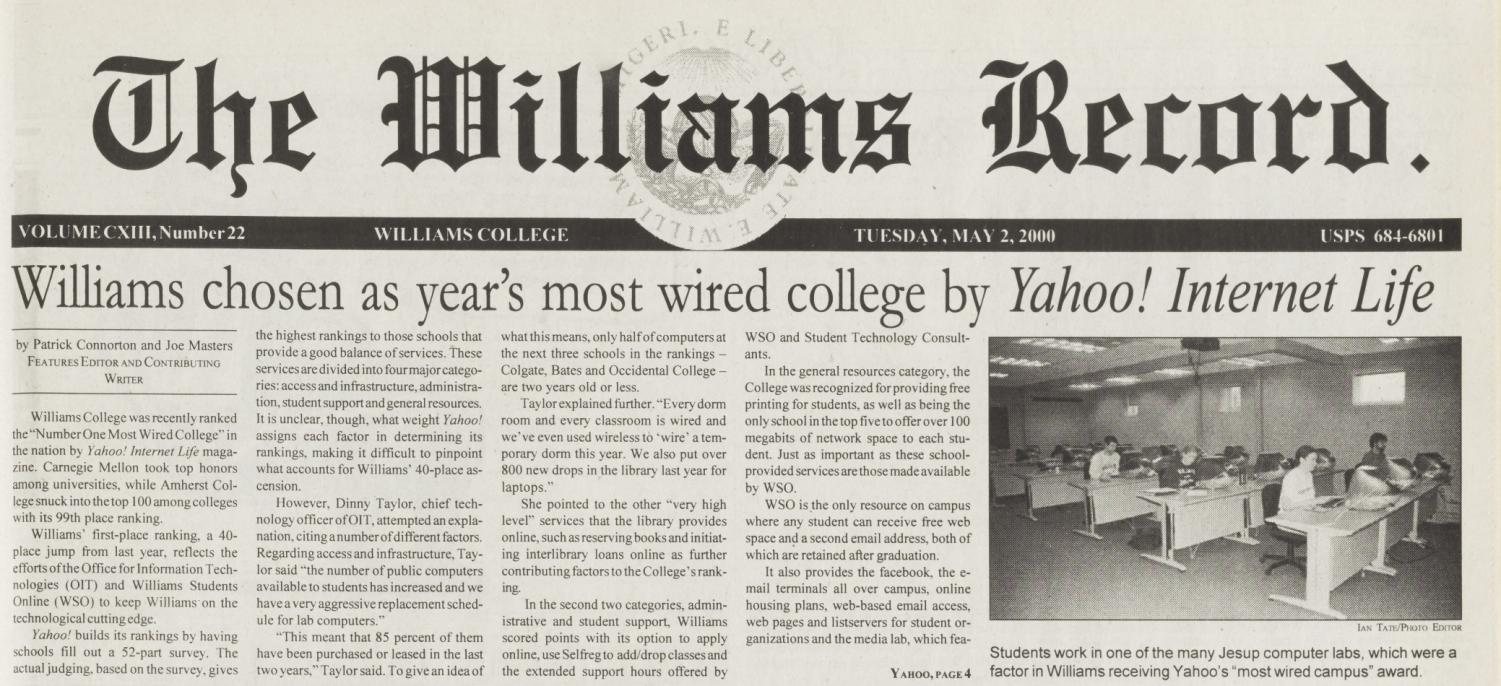This Week in Williams History: Record founded, Town fears loss of fraternity tax revenue, College praised for internet resources
April 26, 2023

“This Week in Williams History” is a column that looks back at memorable moments in the College’s past through articles in the Record. This week in history, the Record began publishing, the College considered purchasing fraternity houses, and the College was deemed “most wired.”
April 23, 1887: The Record is founded — under a different name
In April 1887, students at the College published a newspaper called The Williams Weekly under the editorship of E.J. Thomas, Class of 1888. The first edition of this paper printed 1,000 copies that sold for 10 cents apiece. The paper was later renamed The Williams Record, and it still publishes 136 years later.
An April 28, 1987, Record article celebrated the paper’s centennial anniversary. The article described how the first edition of the Weekly featured a story on the baseball team’s recent loss, a selection of poetry, and a section called “Intercollegiate Notes” dedicated to “attacking Amherst.”
The Record also reported that the Weekly started publishing twice a week in 1904, prompting a name change to the Record. These early editions focused mostly — and sometimes entirely — on athletics at the College. The Record published biweekly until 1978, when it returned to a weekly format.
As students celebrated the 100-year anniversary of the Record in 1987, they also reflected on the many world events that the paper had covered — from national phenomena like the two World Wars and the Civil Rights Movement to the College’s move toward coeducation and the abolition of fraternities.
“Whatever else can be said (and we can sure say it), the Record has survived 100 years,” the editorial board wrote in 1987. Now, it’s survived 136.
May 1, 1963: “Town to lose $50,000 in taxes”
The Record reported in May 1963 that Town residents were concerned about the potential loss of tax revenue from the College’s fraternity houses.Fraternities were gradually phased out of the campus social system in the 1960s. The College considered assuming ownership of the properties, which were owned by the fraternities themselves, but questions emerged about the proposal’s impact on the Williamstown economy.
In 1963, 15 fraternities owned 38.1 acres of land in town valued at $104,720 total, the Record reported. Combined, all of the buildings were evaluated at nearly $1.5 million and provided a yearly property tax to the Town of $44,346.33. The Record announced that Greek life at the College was therefore responsible for nearly five percent of the Town’s annual income of $1,081,908.64.
Then-Assistant College Treasurer Shane Riorden told the Record that the properties could remain taxable if they were owned by the College but leased to fraternities, or if they were used by the College for non-educational purposes. However, if the properties were used for educational purposes — including student housing — the Town would lose the tax revenue.
The College considered a reimbursement policy in which it would voluntarily pay the Town this amount and gradually reduce it in stages over several years. Riorden told the Record that the Treasurer’s Office would not formally announce this plan unless the properties were acquired by the College.
Ultimately, all but one of the 15 fraternities agreed to sell, lease, or donate their houses to the College over the following decade. The one holdout, Phi Gamma Delta, decided to sell its house on North Street to the Town. According to WAMC Northeast Public Radio, the Phi Gamma Delta house became Williamstown’s Town Hall in 1967, and it still serves this purpose today.
May 2, 2000: “Williams chosen as year’s ‘most wired’ college by Yahoo! Internet Life”
The Record announced on May 2, 2000, that the College had earned the title of “Number One Most Wired College” from Yahoo! Internet Life magazine. The College’s jump from 40th place in 1999 to the first-place title one year later emerged as a result of new efforts by the Office of Information Technology (OIT) and Williams Students Online (WSO) to upgrade technology access at the College.
Yahoo! compiled its list based on surveys that evaluated four factors: access and infrastructure, administration, student support and general resources. Rival Amherst College earned a spot in the ranking as well — at 99 out of 100. Williams, however, was praised for its library services, application process, and course registration system, all of which were online.
The magazine also praised the support services offered by WSO. WSO was responsible for creating the student “facebook” directory, student email addresses, and Listservs for student organizations. At the time, they were also working on a facebook for faculty that exists today.
OIT’s Chief Technology Officer in 2000, Dinny Taylor, told the Record that an increase in the number of public computers at the College and a high turnover of replacements for lab computers may have caused the jump in ranking.
Both OIT and WSO expressed a desire to continue supporting the College with cutting-edge technology. “To me, being named number one presents a challenge,” Taylor said. “We now need to focus on working with faculty to bring better technology into their teaching.”








